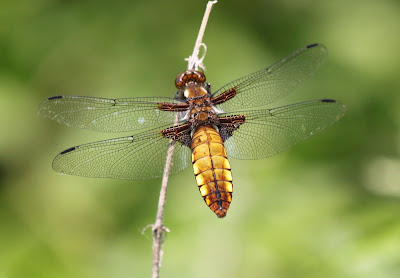The main objective today was to visit the owners of the Farm lake that I have been visiting for over ten years as they are moving to pastures new tomorrow . They have allowed me access , whenever I have wanted , and can only thank them for all the pleasure that their lake has given me over the years . A bonus was that they had mentioned me to the new owners and they are quite happy for me to carry on as before , so it was a case of sadness on their departure and gladness that I can carry on , treating their lake as mine . I made my usual visit , to what I must say was a fairly subdued lake , finding damselflies far more abundant than dragonflies , but still the odd surprise came along . Blue-
tailed Damselflies were the most numerous species seen , with plenty of mature males , like this one having his breakfast , a moth I saw him catch . Plenty of females around too in their various colours ,
form violacea ,
form rufescens ,
and form rufescens-obsoleta , a sandy coloured specimen , this one in 'the ring' with her male .
In one corner of the lake , a small , fast flying dragonfly had me spending a lot of time and energy ,
trying to get a shot of this little jewel in the air , a male Downy Emerald , one of three recorded today . Anyone who has tried will know just how exasperating this species can be to photograph . Whilst walking through the bankside vegetation , a medium sized dragonfly took off and landed some way further on . A search of the landing area confirmed my suspicions , a freshly emerged
Black Tailed Skimmer . Like yesterday's Broad Bodied Chaser , all newly emerged specimens have this gold and black colouration . The female will keep these colours , but the male will get a powder blue abdomen , topped off with a black tip , hence their name . The strongly tapering tip to the abdomen and the claspers at the very tip , with which he will hold the female at the back of the head in order to mate on the wing , make this specimen a male . The female has a less tapering tip to her abdomen and obviously lacks the claspers .
A close up shows the muscular thorax , the engine-house of the insect , enabling it effortless flight and high speed change of direction . Also that most of the insect's head is taken up by those enormous compound eyes , giving it all round vision . The answer to the question once
again was yes , and this shot also shows one of the points that separate dragonflies and damselflies . Those large compound eyes of dragonflies come together at the top of the head , whereas the eyes of damselflies sit either side of the head , far from touching . After the photo call , I went back to where
he had lifted off from and after a bit of searching found his exuvia . I had thought I had seen one earlier , but when I got back to the corner I started from , I was able to confirm my sighting when I
found a male Emperor Dragonfly , my first this year , some way off on the back of a reedbed . Hopefully closer shots will come soon . Whilst trying to get this shot , a pair of Four-spotted Chasers mated on the wing in the same bay , but never came near the camera .Butterflies were few and far between , but I did record Peacock , Small Heath , Holly Blue , Green-veined , Small and Large White ( pictured
nectaring on Ragged Robin ) . The day flying moths Siver Y and Burnet Companion were also seen .
Other interest seen were a Roe Buck which chased off through the orchard on my arrival , two Hobbies doing acrobatics over the woods and loads of Dace of all different ages around the margins
of the lake . And finally , whilst looking through other shots taken at Spring Park Pond yesterday , having been under the impression that all the newts photographed were Common / Smooth , I found
just a single shot of one that wasn't . Looks like any of the other males chasing a female , but that filament on the end of the male's tail , makes him a Palmate Newt .
10 hours ago
























































